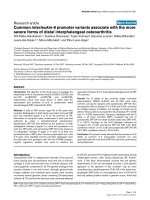Lecture Essay writing & presentation skills - Lecture 6: Writing an essay with the help of outline
Bạn đang xem bản rút gọn của tài liệu. Xem và tải ngay bản đầy đủ của tài liệu tại đây (159.33 KB, 22 trang )
Lecture 6
Writing an Essay
with the help of
Outline
Recap
•
•
•
•
•
•
•
What is Paragraph?
Examples of Paragraph writing
What is Essay?
What makes a good essay?
Dos and Don'ts
How to Write an Essay?
Essay Format
2
What is an Outline?
• An outline is a way of organizing key
ideas
• An outline helps to set up an essay
• An outline is a tool to help revise an essay
What is it?
• An outline is a general plan of the
material that is to be presented on a
paper.
• The outline shows the order of the various
topics, the relative importance of each,
and the relationship between the various
parts.
Types of Outlines
Topic outline
the headings are
given in single
words or brief
phrases
Sentence outline
all the headings
are expressed in
complete
sentences
Rules for Outlining
1. Subdivide topics by a system of numbers and letters,
followed by a period.
Example:
I.
A.
B.
1.
2.
a.
b.
II.
A.
B.
Rules for Outlining
2.
Each heading and subheading must
have at least two parts.
3.
Headings for parts of the paper such
as,
Introduction and Conclusion,
should not be used.
4.
Be consistent. Do not mix up the two
types of outlines. Use either whole
sentences of brief phrases, but not both.
Examples
Sentence Outline
“Choices in College and After”
The decisions I have to make in choosing
college courses, depend on larger questions I am
beginning to ask myself about my life’s work.
Thesis:
I. I have two decisions to make with respect to choosing college courses
in the immediate future.
A. One is whether to select a course in art history or in chemistry.
1. One time in my life, I planned to be a chemical engineer professionally.
2. On the other hand, I enjoy art and plan to travel and see more of it.
B. The second decision is whether to continue a third year of French beyond
the basic college requirement.
1. French might be useful both in engineering and travel.
2. Furthermore, I am eager to read good books which are written in French.
3. How necessary are these considerations in the light of other courses I might take
instead?
II. My problem can be put in the form of a dilemma involving larger
questions about my whole future.
A. On the one hand I want to hold a highly-trained position in a moneymaking profession.
B. On the other hand I want to lead a certain kind of life, with capacities for
values not connected with the making of money.
III. I will have to make a decision balancing the conflicting needs I have
described.
A. I will hold open the professional possibilities by selecting chemistry.
B. I will improve and solidify what cultural proficiency in another language I
have already gained, by electing French.
Topic Outline
“Choices in College and After”
Thesis:
The decisions I have to make in choosing
college
courses, depend on larger questions
I am
beginning to ask myself about
my life’s work.
I. Two decisions described
A. Art history or chemistry
1. Professional considerations
2. Personal considerations
B. A third year of French?
1. Practical advantages of knowing a foreign language
2. Intellectual advantages
3. The issue of necessity
II. Definition of the problem
A. Decisions about occupation
B. Decisions about a kind of life to lead
III. Temporary resolution of the problem
A. To hold open a professional possibility: chemistry
B. To take advantage of cultural gains already made: French
Time to Compare!
• Exchange your scratch outline with a partner.
• Have a five-minute discussion in which you take
turns explaining what you wrote in your outline.
So How to Make and Use an Essay
Outline???
• An essay outline is probably the most
important friend you will have while
writing your essay.
• It is the skeleton of your ideas.
• It is the framework by which you will
write a killer essay. And frankly, it is
difficult to write one without an outline.
When you begin writing an essay outline, use the following model as a
guide:
I. INTRODUCTION:
Thesis:_____________________________________________________.
II. BODY PARAGRAPH 1:
Opening Sentence:___________________________________________.
Detail 1:____________________________________________________.
Detail 2:____________________________________________________.
Detail 3:____________________________________________________.
III. BODY PARAGRAPH II:
Transition/Opening Sentence:__________________________________.
Detail 1:____________________________________________________.
Detail 2:____________________________________________________.
Detail 3:____________________________________________________.
IV. BODY PARAGRAPH III:
Transition/Opening Sentence:__________________________________.
Detail 1:____________________________________________________.
Detail 2:____________________________________________________.
Detail 3:____________________________________________________.
V. BODY PARAGRAPH IV:
Transition/Opening Sentence:__________________________________.
Detail 1:____________________________________________________.
Detail 2:____________________________________________________.
Detail 3:____________________________________________________.
VI. CONCLUSION:
Reconfirmed Thesis:_________________________________________.
How does it do that?
An Outline Organizes The Major Parts Of Your Essay:
•
•
•
•
•
Thesis Statement- The sentence that tells your reader your ultimate
point and what they should expect.
Major PointsThe facts that you are using to prove your
main
point.
Supporting Details- The examples, facts, quotations, etc.
TransitionsThe statement or information you will use to
transition
form one major point to the next.
Concluding ThoughtsAny thoughts that you would like to include
at the close
of your paper to wrap things up and tie it
all together.
NEVER INCLUDE NEW FACTS OR
INFORMATION IN
YOUR CONCLUSION!
Why Write An Outline?
It will help you organize all of the ideas running
around your brain!
Why Write An Outline?
It will allow you to find any gaps in your research or
ideas early enough to fix them.
Why Write An Outline?
It will make writing you essay less stressful because
you will KNOW what you have to work with.
Why Write An Outline?
Professors are often willing to look over an outline for
you to make sure that you are on the right track!
Summary
Let’s summarize what you have learned:
I. What is an Outline?
A. Sentence outline
B. Topic Outline
II. Purpose for Using an Outline
A. To help organize key ideas in writing an essay or
research paper
B. To help summarize key ideas in reading
C. To help you develop subtopics
References
• />• www.rcc.mass.edu/wc/OUTLINING.ppt
• www.worldofteaching.com/powerpoints/en
glish/Basic Guide
• cbhsls.wikispaces.com/file/view/Writing_A
n_Essay_Outline









